Small Wind Turbine Site Selection
By: Rob Beckers
Wind is the fuel that drives a wind turbine. A windmill needs to be placed where the wind is; putting it on too short a tower is like installing solar panels in the shade. Neither will work very well. This section is intended to help you decide what tower height and location gives you the best bang for your buck.
Not just any wind will do, a wind turbine needs air that moves uniformly in the same direction. Eddies and swirls, ‘turbulence’ in short, do not make good fuel for a wind turbine. The rotor cannot extract energy from turbulent wind, and the constantly changing wind direction due to turbulence causes excessive wear and premature failure of your turbine. This means that you want to place your turbine high enough to catch strong winds, and above turbulent air. Since the tower price goes up quickly with height there is a limit to what is practical and affordable.
Here are shortcuts to the sections discussed below:
Obstacle Clearance
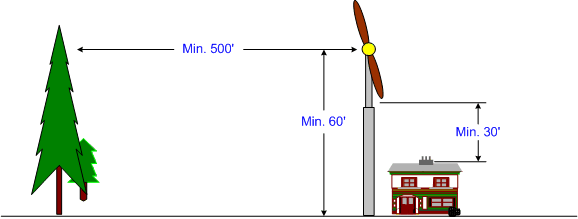
Turbine height & clearance requirements
The quick-and-dirty rule of thumb for turbine height is a minimum of 10 meters (30 feet) plus the length of a turbine blade above the tallest obstacle (trees, house etc.) in a 150 meter (500 feet) radius, with a tower height of at least 19 meters (60 feet). If the obstacle is more solid than a few trees (for example a whole tree line) then even more distance than 500′ is needed, as will be described below.
This should really be regarded as an absolute minimum for a wind turbine; at 10 meters above an obstacle there will still be some amount of turbulence and additional clearance is highly desirable. Keep changes in height of obstacles in mind as well. For example, if you have trees that are expected to grow up to 60 feet high, it is advisable to use a 100 feet tower. Likewise, a 60 feet tower should only be used when the terrain is very, very flat with no obstacles in a wide area around, for example at the edge of the sea, or on top of a cliff with a clear area around it, or in the tundra. For most situations a 60 feet tower will only save a little money up front, while short selling energy production in the long run.
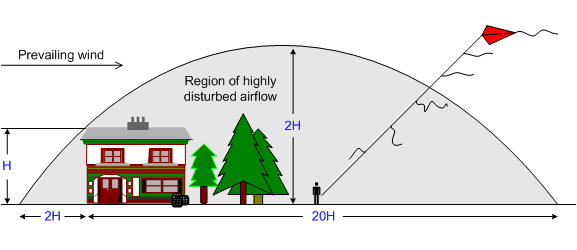
Disturbed air around obstacles
To go beyond the rule of thumb, the airflow over any blunt obstruction, including a tree, tends to create a “bubble” of turbulent air of twice the height of the obstacle, extending 20 times the height of the obstacle behind it. So, your 30 feet high house disturbs the air up to 600 feet away. That tree line with 100 feet trees disturbs the air up to 200 feet high at a distance of 1000 feet away! The figure above illustrates this. Locate your wind turbine either upwind of the obstructions, or far enough downwind. Notice from the figure that preference should be given to a site upwind of obstructions, but keep in mind that tall features downwind of the turbine can also influence the wind going through the blades, as shown in the figure.
Upwind and downwind are relative to the prevailing wind direction; where the wind blows from most of the time. A wind atlas can sometimes tell you what your prevailing wind direction is, and if there is one at all. Some sites have winds that did not read the rule book, and there it is equally likely to blow from more than one direction.
Wind Over Hills & Cliffs
When it comes to wind turbines, the bottom of a hill, valley, or ravine makes for a poor place to site a windmill. The wind tends to drop in speed at the bottom of a smooth hill, then speed up as it goes up the hill, reaching around twice the wind speed at the top of the hill. The figure below shows this. You can use this effect to your advantage if you have hills on your property.
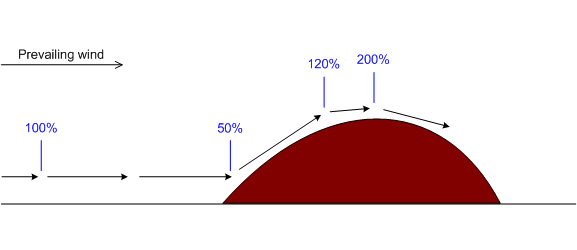
Wind speed over a ridge
For obstructions that are not smooth, such as a cliff (i.e. a sudden rise in the landscape) it gets trickier: Sharp edges create turbulence, as illustrated in the figure below. The airflow at the top of the cliff can be stronger than the average wind speed in the area, but close to the cliff’s edge it may also be very turbulent, making it a poor site for a turbine. If you have a cliff edge on your property and want to use it for siting your turbine, you should still use a 60 feet high tower to get above turbulent air. Even if it seems that the wind is always blowing hard at the cliff’s edge.
The lee side (downwind of the prevailing winds) of a bluff object makes for a very poor wind turbine site. The bluff object will create large turbulence on its downwind side, and the average wind speed will drop off precipitously as well. This leaves no energy for the wind turbine to harvest.
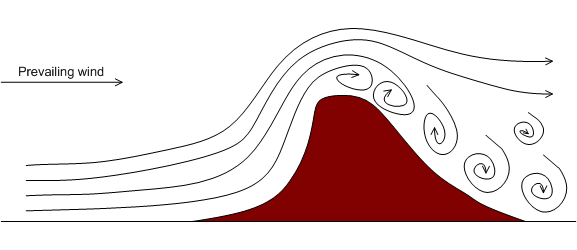
Turbulence on the lee side of a cliff
There actually is a cheap way to visually find out at what height turbulent air ends, and smooth, laminar airflow begins. Just fly a kite at your proposed wind turbine location on a windy day, preferably when the wind is coming from the prevailing direction. To visualize airflow, use tape-streamers tied to the kite’s string every 15 feet or so (home improvement stores sell plastic marking tape in fluorescent colors for very little money). Wildly fluttering tape indicates turbulence, smoothly extended tape means smooth air. Be sure to take the angle of the kite’s string into account when calculating height.
Wind Power vs. Tower Height
The energy in the wind increases with the cube of the wind speed (P ~ v3), and wind speed increases with height. An increase of just 26% in wind speed means twice as much power is available in the wind, and your wind turbine will produce almost twice as much. Double the wind speed and you can harvest almost eight times as much power! A small additional investment in tower height may therefore be well worth it, thanks to the increased energy production. If you know the annual average wind speed for your location (from weather data, a wind atlas, local weather station etc.) you can use the manufacturer’s data to get a good idea of the energy that the wind turbine will produce if placed in smooth, laminar airflow. Weather data usually reports wind speeds at 10 meters above ground level, be sure to translate this to a wind speed at turbine hub height. For a quick idea of how changes in tower height affect the power in the wind for an unobstructed site see the figure below.
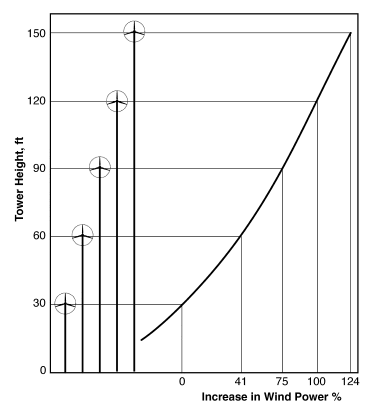
Wind turbine height vs. power
The Danish Wind Power Association made a very nice, interactive, calculator that allows one to plug in various obstacles (for example, a row of trees), set their height and distance to the wind turbine, and visually show what effect this will have on wind speed and energy. The calculator shows the percentage of the wind speed at various distances and heights behind the obstacle. Keep in mind though that the effect of obstacles is not just to diminish wind speeds, but they also make the air swirl, creating turbulence. Turbulence is an energy thief when it comes to wind turbines.
If you have sufficient space for guy wires, we advise to use a tilt-up tower for your wind turbine. They are economical, costing only a little bit more than the cheapest type of tower (a fixed guyed tower), and allow the turbine to be installed on the ground. Maintenance can also be done on the ground, by tilting the tower down. This saves in crane expenses, and makes installation and maintenance much safer because the work does not have to be done at dangerous heights.
Another aspect of proper windmill siting is the distance from occupied buildings. All wind turbines produce some amount of sound. Some wind turbines are more quiet than others, and in particular the frequency content of the sound they produce varies, but even a quiet turbine produces sound. Some people find its sound soothing, since it tells them they are making energy, while it drives others absolutely bonkers. For that reason it is a good idea to place your wind turbine some distance away from your house, 100 feet is a good number for minimum separation. That is not to say that closer cannot be done, but you will have to honestly assess how the turbine’s sound will affect you. Generally, a wind turbine that is placed in smooth air will be more quiet versus the same turbine in turbulent air, unless the wind starts blowing hard. At that point most turbines operate in stall mode, causing the air to swirl across the blades instead of flowing smoothly, and this increases the audible sound. When this happens it can be heard over the wind when you are in close proximity (and downwind sound will carry further than upwind). There also is such a thing as too much distance, since the length and gauge of the wiring that is needed will increase. With the ever-increasing price of copper this makes it more expensive to install your turbine (for large distances aluminum wire may be an option – something to keep in mind).
Not-So-Bright Ideas
Since we are talking about buildings: Despite the current marketing pitch of many small wind turbine manufacturers and sales people, it is generally a very bad idea to mount a wind turbine (any turbine) directly onto a building. The airflow that close to the building is generally very turbulent, leading to premature failure and poor power production. It is usually noisy too. Every wind turbine has some amount of vibration associated with it, and this too will be transmitted inside the house. We know, the thought of bolting a little turbine to the house, just over the roof line, to offset your electricity use (as that salesman put it) is appealing. The harsh reality is that this does not work: Several studies were done, involving dozens of roof-top-turbines. They all concluded that those turbines do not work. Their energy production is negligible, and some were even net-users of electricity (because their inverters draw power, even when nothing is going into the grid)! Just say “no” to building mounted turbines!
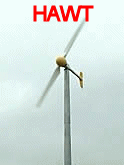
 By the way, the same siting rules also apply to Vertical Axis Wind Turbines (or VAWTs). The regular propeller type turbines are Horizontal Axis Wind Turbines (or HAWTs). Currently, many new vertical axis designs are being touted as the next-best-thing since sliced bread; sales people will tell you “they work in turbulent air”, and “they do not need a tall tower”. Alas, none if this is true. They need fuel just like any other wind turbine, and that fuel is wind. They also need nice, clean, laminar airflow to do their job. Since they are omni-directional they are a little less sensitive to rapidly changing wind directions (though a HAWT will just as readily follow the wind direction by yawing). Do not be fooled: If the wind at your site changes direction continuously it usually means you have lots of turbulence, and no wind turbine (a VAWT included) will do well at such a site.
By the way, the same siting rules also apply to Vertical Axis Wind Turbines (or VAWTs). The regular propeller type turbines are Horizontal Axis Wind Turbines (or HAWTs). Currently, many new vertical axis designs are being touted as the next-best-thing since sliced bread; sales people will tell you “they work in turbulent air”, and “they do not need a tall tower”. Alas, none if this is true. They need fuel just like any other wind turbine, and that fuel is wind. They also need nice, clean, laminar airflow to do their job. Since they are omni-directional they are a little less sensitive to rapidly changing wind directions (though a HAWT will just as readily follow the wind direction by yawing). Do not be fooled: If the wind at your site changes direction continuously it usually means you have lots of turbulence, and no wind turbine (a VAWT included) will do well at such a site.



